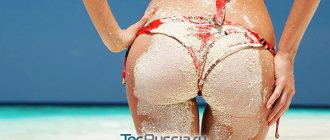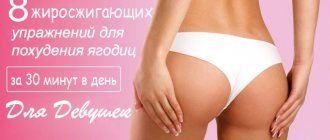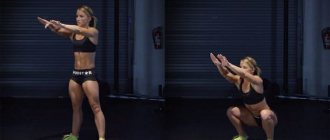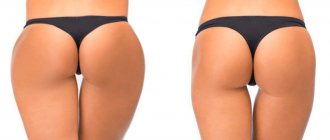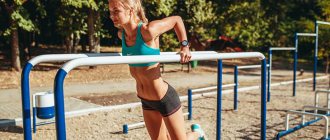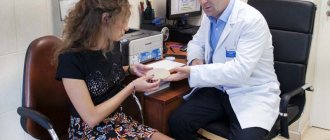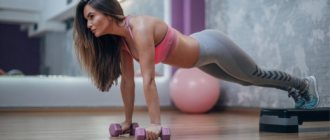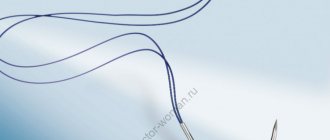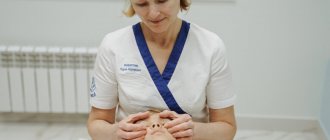A butt lift is a popular surgical procedure, the purpose of which is to correct the shape of the “fifth point”, as well as to give it enlargement and volume in certain places, depending on the location of the problem. At the present stage, the cult of flat buttocks is gradually becoming a thing of the past, giving way to the idea that the hips should be moderately luxurious and elastic. Considering the desire of many women to be attractive, advances in plastic surgery in this area make it possible to achieve effective and lasting results.
- Indications for buttock lifting and correction
- Degrees of tissue subsidence
- Non-surgical butt lift products
- Shapewear and tights
- Injection techniques
- Non-surgical method - filament lifting
- Fat grafting liposculpture
- How the operation is performed
- Top brace
- Lateral lift
- Medial butterfly lift
- Rehabilitation period
- Possible complications and side effects
- How long does the effect last?
- Lifting and endoprosthetics
- What are gluteal endoprostheses?
- Implant installation methods
- Features of the recovery period after buttock augmentation
- Effective exercises for the buttocks
- Squats
- Plie
- Deadlift or deadlift
- Swing your legs back
- Lunges forward
- Gluteal bridge
- Glute walk
- Exercise chair
- Steps forward with the platform
- Hyperextension
Indications for buttock lifting and correction
Toned buttocks are the dream of every representative of the fair sex. However, due to the hereditary factor, not everyone can boast of beautiful forms. This is one of the possible reasons for surgical correction. Also, when a person’s weight constantly “jumps” (due to strict diets and obesity), the skin on the buttocks overstretches and loses its elasticity. The gluteal muscles seem to “blur”, losing their clear contour, and they droop (ptosis) with an increase in vertical size.
Age plays an equally significant role. It is known that the older a person gets, the more the skin loses its elasticity. Accordingly, older women often want to improve the shape of their “butt”, which becomes the reason for turning to plastic surgeons.
Another reason for tissue prolapse is unsuccessful aggressive intervention that took place in the past. As a result of unsuccessful plastic surgery, the ligamentous apparatus of the gluteal muscles may be damaged. Typically, this occurs when liposuction was performed poorly and unsuccessfully.
What do you need to know before starting training?
When pumping muscles, not necessarily the gluteal ones, you should know about two important processes for athletes : anabolism and catabolism.
The names are unusual and scary, but their essence is simple. Anabolism allows us to build muscle mass. Catabolism is the reverse process of anabolism. That is, during catabolism, muscle fibers are destroyed. These processes cannot occur in the human body simultaneously. In addition, they have different prerequisites. Anabolism begins with excess caloric intake and intense training. On the contrary, catabolism requires a calorie deficit. Therefore, if you want a great butt, you will have to forget about any attempts to lose weight through diets. If a woman is overweight, then it makes no sense for her to start pumping up her buttocks, since with anabolism the total body weight will become even greater. To begin with, an overweight lady will have to lose weight. Then go through a program to increase the gluteal muscles , and then lose weight again. As you can see, an obese woman will have to put in a lot more effort to get a great butt.
A thin woman can, from the very beginning, allow herself to have an excess calorie diet and exercise for muscle hypertrophy.
Degrees of tissue subsidence
Regarding tissue prolapse, both ptosis and preptosis are distinguished among them. Distinctions are made based on how pronounced the skin fold that occupies the border of the back of the thighs is. Its length is measured by mentally “drawing” a line along the middle of the thigh from behind. If there is no ptosis, the fold is also absent, or it may occupy only the posterior inner surfaces of the thighs. Next they talk about the following stages:
- the skin fold is pronounced, but it does not yet reach the middle of the thigh (preptosis is minimal);
- the fold already occupies the middle of the thigh, but without crossing it (moderate preptosis);
- the skin fold crosses the midline (borderline stage of preptosis);
- sharp expression of the fold with strong prolapse of soft tissues (deep or true ptosis).
Calf raise
Standing calf raises help make your legs slimmer and your butt more toned.
Calf raises are a fairly simple exercise. It does not pump up the butt muscles, but is aimed at your lower legs - the calf and soleus muscles. But, as I wrote above, beautiful calves indirectly affect the butt. They lift it up visually. Another advantage of carved and sculpted shins is that they visually make the knees narrower and the legs look slimmer.
There are two main ways to do this exercise: standing and sitting. But they are fundamentally different. While standing, you train the calf muscle, while sitting, the soleus muscle, which is located under the gastrocnemius. Both muscles make your calves look bigger. Therefore, you need to do both versions of this exercise, both standing and sitting.
How to do calf raises while standing? You need to find some kind of stand or threshold. Stand with your toes on the stand so that your heels hang down. It is advisable to stand near a wall or chair so that you can hold on with your hands. Slowly rise onto your toes, then pause for a moment and lower yourself.
Seated calf raise. Working out the shins tightens the butt and makes it taller.
You can use additional weights to increase the load. This could be dumbbells, water bottles or a backpack.
How to do calf raises while sitting? The sitting calf raise technique is similar to the standing calf raise technique. But when lifting while sitting, be sure to use additional weights: dumbbells or water bottles. Sit on a chair, put your socks on a stand, place dumbbells on your knees, holding them with your hands. Slowly raise and lower your knees, pausing momentarily in the highest and lowest positions. Lower your heels as low as possible, stretching your calves. Inhale as you rise, exhale as you lower.
Note: it is not necessary to use a stand; you can push off with your toes from the floor, but with a stand the exercise will be more effective.
Non-surgical butt lift products
Among non-surgical techniques, manipulation such as buttock lifting with threads (filament lifting) and injection methods are gradually gaining popularity. Those women who have not yet decided to undergo any procedure prefer to use tights and underwear.
Shapewear and tights
People first started talking about the so-called “Brazilian butt” when women's nylon tights, equipped with elastic inserts in the buttock area, began to go on sale en masse. Now, in addition to tights, there are also shorts, tights and bodysuits.
Of course, they can help a woman out if she wants to wear a tight dress, but sooner or later they will still have to be removed - and then the whole effect of a beautiful figure will evaporate in the blink of an eye. That is why lifting the thighs and buttocks is in greater demand in specialized clinics, where it can be performed in a gentle, almost non-surgical way.
Injection techniques
Injection techniques usually include biorevitalization, mesotherapy and the use of fillers with hyaluronic acid. It is known that meso-cocktails and hyaluronic acid have a nourishing effect on the skin, providing a pronounced tightening effect. Injections can also be done for preventive purposes - so that the tissues do not sag too much, but the most common indication for them is severe ptosis.
For the buttocks, it is also possible to use fillers, but not for volume purposes, but to create a clear contour. Fillers are also injected if the existing implant in the buttock area begins to contour and deform.
Non-surgical method - filament lifting
Filament lifting, or buttock lifting with threads, is done using local anesthesia and is notable for the fact that it has virtually no contraindications. After the procedure, there will be no need for a long recovery period, and the threads introduced under the skin promote the redistribution of soft tissues, thereby correcting the shape and size of the “fifth point”.
The duration of the session is no more than an hour, and after the manipulation the patient can immediately go home. Of course, in the first days, unpleasant pain is often observed at the sites where the threads are inserted, as well as swelling and bruising. Wearing supportive underwear will help here (at least two to three weeks). It is important not to subject the body to any physical stress and to refrain from saunas, steam baths and hot baths.
Unfortunately, the effect of such a procedure does not last long, and deep ptosis cannot be corrected with its help.
Is it possible to pump up your butt with or without protein?
Recently, there are many tools designed to provide assistance and support in achieving goals. One method to achieve results faster is to consume protein. Today it is offered in a variety of forms and is sold as tablets, solutions, and ampoules. Protein allows muscles to have a quick recovery after stress during squats and other exercises. But many people who have tried the protein have given very mixed reviews about this product. Some people think that artificial protein, although it helps you get a sexy butt, is harmful to your health. And some are convinced that without it it is problematic to make the exercises effective.
If you are just starting your exercise routine, you should refrain from using chemical sources of this substance in favor of natural products containing it in large quantities. Natural protein is healthier. Since it is contained in products that nutritionists and other experts recommend consuming when necessary to pump up the gluteal muscles. If you want to use protein, it is recommended to start your exercises with a whey product, since it is the easiest to use and the least dangerous.
How the operation is performed
In the field of fat grafting, there are several operational techniques that allow you to correct different places in a particular area. She solves such issues as lifting the butt in its upper part, how to tighten the lower part of the buttocks, which is most vulnerable to prolapse and subsequent deformation.
Top brace
In order to tighten the breeches and lower gluteal muscles, the surgeon excises a strip of skin, the width of which can be up to 15 cm. The excision occurs in the upper sections, and when the wound is sutured, the same tightening effect occurs. This is how severe ptosis can be eliminated for a long time.
Lateral lift
With its help, all excess skin is removed from the outside (for example, in cases of severe obesity and deformation). The method also eliminates mild ptosis.
Medial butterfly lift
With its help, the phenomena of deep ptosis are effectively eliminated, and the volume becomes larger. After removing excess skin, the surgeon closes the edges of the wounds with sutures, which are applied in several rows. They sew together the subcutaneous tissue, then the fascia, and finally the skin.
Skin stitching is carried out with special intradermal threads, without the need for further removal. External changes can be observed immediately after surgery, but the final result will be visible only after the swelling subsides.
How to squat correctly to pump up your butt description and video
To achieve results, mandatory adherence to techniques and technologies is required.
- All exercises should be done slowly, deliberately and consciously.
- It is important to follow a sequence of techniques to ensure uniform load.
- Do not overdo it with certain techniques.
- If there is insufficient load, significant weight can be created.
- Regular exercise is the key to success in this area.
- Following the principles of proper nutrition will lead to results faster.
In the video you can see the basic rules and subtleties of performing exercises that will allow you to achieve an original and rational result in a short period of time.
Rehabilitation period
In the first 24 hours after surgery, the patient will be transferred to the intensive care unit to rule out complications after general anesthesia. Discharge takes place after two or three days, with a further outpatient visit to the surgeon.
It should be remembered that compression garments will only be needed if liposuction was performed along with the lift. During the first weeks of the postoperative period, you will have to come to terms with the fact that there will be swelling and bruising on the skin of the buttocks with severe pain. Usually, they are easily eliminated by taking painkillers.
An undoubted advantage is that the patient can sit already two or three days after the plastic surgery, and if necessary, you can even drive. After two to three weeks, the swelling gradually begins to go away, and after two to three months it will completely resolve. During this period the final effect is assessed.
As long as there is swelling on the body, visiting baths, saunas, swimming pools and gyms is strictly prohibited. Massage is also unacceptable. All these activities will contribute to additional trauma and increase the rehabilitation period.
How long does the effect last?
Tight buttocks retain their spectacular appearance if the surgeon’s work was carried out at the highest level, and the duration of the result varies from seven to ten years. Much will depend on whether the patient after the operation will be able to monitor the stability of his weight and promptly treat existing diseases, especially if this concerns serious hormonal imbalances. Here are some photos before and after butt lift surgery:
Squats
Banal squats still lead the list of the best exercises for the gluteus maximus, quadriceps, soleus and adductor muscles of the thigh. To make them more effective, pay attention to the following rules:
- legs should be spread wide
- arms extended forward
- Don't lift your heels off the floor
- you can't bend your back
- Don’t rush and make movements quickly: train slowly, feeling your muscles
- ideal option: 4 sets of 15 times
Lifting and endoprosthetics
If there is such a possibility, tightening and replenishment of the required tissue volume is carried out using the patient’s own biomaterial, excised during the operation. However, if it is not enough, surgeons suggest installing endoprostheses into the cavity of the buttocks - a gluteoplasty operation.
What are gluteal endoprostheses?
In appearance, they resemble implants that are installed in women for breast correction. Endoprostheses consist of an internal filler in the form of a gel, and are covered with a dense shell of silicone material. The gel has a unique structure: if the implants rupture, it will not go beyond the damaged prosthesis and will not cause any harm to the body.
If we compare buttock implants with breast implants, the former are certainly more dense and have the anatomical shape of a pear. They are selected individually - so that the buttock takes on a good volume - without contouring or compressing the sciatic nerve.
Implant installation methods
There are two main ways to install endoprostheses: subcutaneously and more deeply - under the large buttock muscle. The latter installation option is the most preferable, since in this case the prosthesis is completely covered with muscle tissue, which eliminates its visibility when the body position changes in certain directions. The muscle will also become a good fixator for the implant, holding it in the desired area and not allowing it to move down. The incisions made by surgeons are minimal, and some time after the operation they will not be visible on the skin at all.
Features of the recovery period after buttock augmentation
Patients who have firmly decided to resort to endoprosthetics need to be prepared for the fact that discomfort after such an operation may persist during the first year. During this time, the body gradually gets used to the foreign body. After a year, the sensation that there is, after all, an implant in the body may periodically make itself felt during active muscle contractions or during intense physical activity. Here are the results of buttock augmentation using implants in the photo before and after gluteoplasty:
What results should you expect?
Proper nutrition and regular training in the gym help to have a beneficial effect not only on the part of the body being worked out, but also on health. Have you been following my recommendations for several months now? Surely, you have noticed an increase in immunity and excellent health, as well as the absence of problems with the genitourinary system and back. Your posture will definitely change for the better by strengthening your muscles.
Athletes always stand out in the crowd due to their ideal relief and elastic forms, even if they are wearing several layers of clothing on top. A woman who exercises does not know what cellulite and stretch marks are, she is always graceful, flexible and disciplined. Exercise and proper nutrition are 100% guarantees of a toned, voluminous butt with ideal contours and shapes.
Effective exercises for the buttocks
For those who care about a beautiful body and health in advance, yoga, Pilates and fitness offer good exercises for tightening the buttocks and thighs, which will help prolong youth and will always keep the body in good shape. At the same time, you can exercise at home, without resorting to the services of fitness trainers and gyms.
Squats
Of the squats, the most effective is the plie. Of course, to begin with, you can do regular squats, without lifting the soles of your feet from the floor, stretching your arms forward and squatting at an average pace. Plie is recommended when you need to intensively work out several muscle groups - first without weights, and then with the use of some kind of sports equipment.
Plie
This exercise is perhaps the best for toning the hips. Each squat should be performed carefully, working the muscles of the abdomen, back, pelvis and hips. It is a comprehensive study that will help restore the elasticity of sagging muscle tissue, and one of the best techniques is the following:
- starting position, standing straight, with your chin raised;
- your feet should be placed shoulder-width apart, gradually spreading them wider;
- your arms should be parallel to your body, along it, but in the future you can increase the load by pulling them forward or using small dumbbells;
- Perform the squat itself slowly and gradually, with a deep breath;
- carefully return to the starting position, while exhaling and lifting the dumbbells.
When performing this squat, it is important to ensure that the legs at the knees remain in the shape of a right angle. It is recommended to start with small “portions” of exercise in the form of two or three approaches with repetitions ten times.
Deadlift or deadlift
This exercise should be done while ensuring that your legs remain straight at all times. It perfectly promotes the development of the gluteal and thigh muscles, and the technique for performing it looks like this:
- starting position straight, with toes pointed inward (this will put less strain on the lumbar spine);
- weights, taken in hand, are located near the front femoral part;
- now you need to bend forward so that your knees remain straight;
- It is recommended to move your hands in this direction: from the hip joints to the middle of the shins.
Provided the back is straight, the lumbar region should maintain its normal curve, and when bending forward, it is best to bend the knees slightly. You should start the exercise little by little: two sets of ten times.
Swing your legs back
They work on the bottom of the buttocks, removing the appearance of cellulite underneath them, which makes the figure feminine and attractive. The technique is as follows:
- starting position - kneeling, resting your palms on the floor surface - so that the torso and head are on the same line;
- lift the leg, bent at an angle of 90 degrees, above the floor and lower it - and so on 10 times;
- Also perform the exercise with the other leg.
To begin with, three approaches ten times will be enough, and at the same time, not only the muscles of the butt, but also the legs are worked out. Breathing when performing swings should be free, without delay.
Lunges forward
The exercise perfectly strengthens different muscle groups and helps increase the volume of the “fifth point”. You need to do this:
- starting position - standing, legs slightly apart;
- inhaling, step forward, while the leg should be bent at a right angle, and the squat should be done as deeply as possible;
- during the squat, the leg that is located behind must be fully straightened;
- during execution, ensure that your shoulders are straightened and that your back remains straight;
- exhaling air, gradually return to the starting position, resting on the foot of the leg extended forward.
At the initial stage, two approaches of ten times will be quite enough.
Gluteal bridge
A simple exercise will help lift sagging muscles:
- starting position: lying on the floor (on your back), arms along the body, while your legs should be spaced slightly wider than your shoulders;
- on the way up with bent knees, try to lift the “fifth point” from the surface, resting on your feet;
- hold in this position for 5-10 seconds;
- return to the starting position as you exhale.
Thus, the human body is arched in the shape of a half-bridge, and to increase the load over time, a bolster is placed under the feet. The result will be noticeable within a week.
Glute walk
To complete this you will need a mat. This exercise helps to quickly tighten the skin on the buttocks and thighs:
- starting position - sitting on the floor, with legs folded together;
- then the back straightens, the chin needs to be raised, and the shoulders should be gradually pulled back. This way the load is distributed optimally and evenly;
- Now try to “step” forward with your buttock, pushing off with your heel, simulating the process of walking.
The speed of execution is average, but to begin with, you can set yourself the task of performing three approaches ten times with a multiplicity of 3 to 4 times every 7 days.
Exercise chair
This is one of the types of static exercises that help tighten your butt. It should be performed in an absolutely calm state, but the result will be excellent:
- sit against the wall so that the distance between it and your back is about 50 cm. Place your arms along your body;
- slowly squat, mentally imagining a chair underneath you. Your knees should be bent at a 90-degree angle;
- the back support should be a wall;
- hold in this position for several seconds;
- exhaling air, return to the starting position.
To begin with, five to seven times will be enough. You can gradually increase the load.
Steps forward with the platform
Any small elevation that provides a certain level of load can serve as a platform. In addition to the lifting effect, this helps develop a sense of balance. You need to do this:
- one leg stands on a raised platform;
- the second rises upward, as high as possible. You should try to fix it in this position for a short time;
- do the same with the other leg.
Hyperextension
Several muscle groups are involved. In a sports hall, the exercise takes place on a machine called a Roman chair. You can do hyperextension at home, just lying on the floor, and at the same time, you will achieve not only a tightening, but also improve your posture. This type of hyperextension is also convenient because no one’s help is required when performing it:
- lie on your stomach, you can leave your hands on the back of your head or cross them over your chest. Feet together;
- while inhaling, try to raise the body as high as possible, holding for five seconds;
- while exhaling, return to the starting position.
The optimal number of approaches is three, 10-15 times.
Three gluteus maximus muscles
Gluteus maximus muscle
Did you know that the gluteus maximus muscle is the largest muscle in the entire human body? Its job is to support the torso in an upright position, which is the reason for its size and power.
As the name suggests, it is the largest and closest to the surface muscle of the entire gluteal muscle group.
The function of the gluteus maximus muscle is mainly to extend the upper legs (hips) - for example, when rising from a squat position. Another example of including this muscle in work is lifting the torso tilted forward. Picture yourself swinging a kettlebell and you'll get a good idea of how this muscle works.
Hip extension also occurs during deadlifting, pushing off the legs during running and skating, and simply while swinging the leg.
This muscle is also involved in turning the leg - for clarity, imagine, for example, a duck walk.
Gluteus medius muscle
The gluteus medius is the smallest of the gluteal muscle group, located underneath the gluteus maximus and provides stability to the hip joint, especially when standing on one leg. Thus, when walking or running (where the legs are used in turns) or climbing stairs, the gluteus medius muscle is tensed to prevent the pelvis from sinking to one side.
Moreover, the gluteus medius (and minimus) are involved in hip abduction.
Gluteus minimus
It is the smallest of the gluteal muscle group, located directly below the gluteus medius. Its main function is to provide stability to the hip joint. It works together with the gluteus medius muscle.
I hope that this little anatomical excursion did not confuse you. Essentially, that's all you need to know to perform the exercises. Well, let's move on to...
